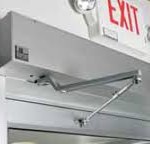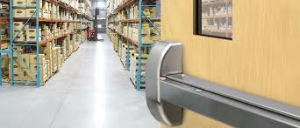Get a Grip on Ontario’s Fire Codes for Doors & Entryways
Owners of houses, apartment buildings and commercial buildings need to know fire code requirements when installing new doors and locks or modifying existing hardware. These requirements are recorded in the Ontario Building Code (OBC) and Ontario Fire Code (OFC), which regulate construction design and materials for buildings in the province. They cover guidelines regarding life safety and fire containment.
The Basis of Ontario’s Fire Codes
 The OBC and OFC regulations on fire safety are based on codes developed by the National Fire Protection Association in Quincy, Massachusetts. The NFPA 80 specifies correct installation and maintenance of fire doors and hardware to protect against the spread of fire and smoke. The NFPA 101, Life Safety Code, covers requirements for the protection of occupants against fire, fumes and panic. Some Ontario municipalities require additional precautions for fire protection than those specified in the OBC or OFC such as main door automatic openers or wider door widths.
The OBC and OFC regulations on fire safety are based on codes developed by the National Fire Protection Association in Quincy, Massachusetts. The NFPA 80 specifies correct installation and maintenance of fire doors and hardware to protect against the spread of fire and smoke. The NFPA 101, Life Safety Code, covers requirements for the protection of occupants against fire, fumes and panic. Some Ontario municipalities require additional precautions for fire protection than those specified in the OBC or OFC such as main door automatic openers or wider door widths.
There are two main principles to be aware of when installing, maintaining or modifying any door, lock or other access device in a building. Together, these principles underlie specific fire code requirements:
- Unrestricted Egress (a clear way out) – Any door that is used as an exit from a building or fire separation door must allow exit by an occupant using normal force, without special steps that could restrict the exit or cause the occupant confusion.
- Fire and Smoke Protection – Fire doors must be certified and correctly installed to curtail the spread of smoke and fire. Modifications must not impede their intended operation
Fire Door Requirements
In general, the OBC and OFC require fire doors on building exits, corridor doors, laundry and garbage rooms. Fire doors must be certified and properly labeled after installation.
Modifications, including the installation of locks or access control mechanisms, must be inspected to ensure they do not compromise the safety, egress and fire containment features of the door and hardware associated with it. They are required to have a self-closing mechanism, which ensures that when they are used by occupants that they still provide protection.
Latching and Locking Free Egress Requirements
 Doors providing egress may have security locks to prevent entrance to a building, but they cannot in any way prevent easy egress. Doors that swing in both directions must provide unhindered egress in both directions. Double cylinder deadbolts or captive keys are not allowed.
Doors providing egress may have security locks to prevent entrance to a building, but they cannot in any way prevent easy egress. Doors that swing in both directions must provide unhindered egress in both directions. Double cylinder deadbolts or captive keys are not allowed.
Egress door latches and locks must be designed in such a way that a panicked person, including children and persons with disabilities, can exit quickly even in the dark.
Ask the Experts
Building and fire codes contain many details and exceptions. At Servcon, we’re well versed in code requirements and industry standards with regard to fire safety. We will ensure that your business complies with provincial and local codes and is secure and safe.
